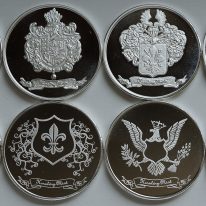A major watershed of silver production was the discovery of the New World in 1492, after which time major silver mines in Mexico, Bolivia, and Peru were opened leading to a rapid rise in the annual world production of silver. This rise, coupled with improved techniques for extracting silver from ore, broadened both the quality and quantity of ore that could be exploited. Later improvements, particularly in the late 19th and early 20th centuries, vastly enhanced the base of silver production and accelerated the exploitation of silver as a byproduct of base-metal mining.
Only about 25 percent of cumulative world silver production occurred before the 1770s. Records remain somewhat incomplete for the periods before 1900, however they play a critical part in determining cumulative historical production.
To learn more, select from the following periods of time. Material adapted in part from the Silver Institute’s Stocks of Silver Around the World publication.
Silver is unique. Its natural beauty is legendary. Its range of applications is exceptionally broad. As a precious metal, it has been a source of human adornment since the beginning of time. As fine tableware, appropriately called silverware, it had served as an important utensil for fine dining for centuries. As a light-sensitive element, it has revolutionized preservation of memories in the form of photographic images. More recently, its unique properties comprising of anti-bacterial qualities, corrosion resistance, malleability, ductility, reflectivity and conductivity have opened new possibilities for a myriad of other industrial applications.
Demand for silver fluctuates yearly. Therefore, in order to gain an objective appreciation of changes occurring in the silver market over time, it is important to take a snapshot of how much and where silver was used in, say 1990, compared to 2002. In 1990, total silver consumption was approximately 701.2 million ounces of which about 26% was used in jewelry and silverware, 31% in photography and 38% in industrial applications. In 2002, the total estimated consumption of silver increased to 863.0 million ounces. The biggest increase in silver consumption over a twelve-year period occurred as a result of a 27.5% increase in the amount of silver used in industrial applications. In 2002, approximately 39% of the silver was consumed in industrial applications.
Silver’s industrial applications continue to expand. For example, major progress has been made towards advancement of new silver-based catalytic converters. Also, the U.S. House of Representatives and the Senate have authorized significant federal research into a potential role for silver in developing new wood preservatives as a substitute for arsenic-based compounds currently used, a silver-based biocide would be an important environmentally-friendly alternative to existing wood preservatives. This application alone could lead to an additional off-take of approximately 120 million ounces of silver per year.
Major breakthroughts are also occurring in the usage of silver in the electronic industry, particularly in the large screen flat panel display television sets, which rely on a new technology wholly dependent upon silver. Flat panel displays consist of two parallel flat sheets of glass. On the back of the glass facing the viewer is a grid of thousands of lines of silver, each thinner than a human hair. These lines conduct the electronic signals activating a special gas that hits color phosphors and more lines of silver on the opposite pane. On impact, these color phosphors react by flashing color for the picture seen by the viewer. The flat panel display is a milestone achievement of microelectronics. It has made the bulky cathode ray tube television technology obsolete. Consultancy Display Search estimates that worldwide sales of flat panel TV displays in 2002 reached approximately 1.82 million. This number is expected to triple by 2004.
Approximately two-thirds of the world’s demand for silver is provided by mine production, which in 2002 reached approximately 585.90 million ounces. The balance is supplied primarily by net government sales and old silver scrap. Over the past decade, there has been a persistent deficit of newly refined silver entering the market compared to fabrication demand. This deficit has been bridged largely through the draw down of silver inventories that were mostly stockpiled during the 1980’s, when silver supplies exceeded demand. As a result of the silver inventory draw down, by the end of 2003, the worldwide stockpile of refined silver has been reduced to levels sufficient to satisfy less than approximately six months of the existing demand.
Silver History
Like many other metals, silver has witnessed two decades of under-development of new reserves, creating a persistent deficit of newly-refined silver entering the market, a widening gap between supply and demand and a gradual depletion of the world’s silver inventories.
Currently, the majority of the world’s silver is produced as a by-product of lead, zinc, copper and gold operations. Large, high grade silver deposits are scarce. Above ground silver inventories have been depleted by over 1.56 billion ounces over the past 11 years, according to Precious Metals Analyst David Morgan.
“The world shortfall of production of more than 100 million ounces a year for 10 years has been narrowing the ratio of physical metal,” states Morgan. “The exhaustion of supplies of silver is foreseeable.”
At present there is no official stockpile of silver anywhere in the world, he notes.
Meanwhile, as global economies such as China, India and Russia continue to expand, so does demand for silver in industrial (39%), photographic (24%) and other uses, such as jewelry and minted coins (37%). Considered both a precious and an industrial metal, silver is used in an ever-expanding scope of applications ranging from catalytic converters to flat screen TV sets to medical equipment and new pharmaceuticals. Total demand for silver rose by 13.3 million troy ounces in 2003, according to The Silver Institute.
Reacting to this fundamental shift in both supply and demand, silver prices climbed sharply in 2004 to over us $8.00 per ounce after remaining beneath the US $5.00 level for over a decade. Within the next two years, consensus in the marketplace forecasts a significantly higher silver price of over $10.00 per ounce.
Top Ten Silver Producing Countries: (Millions of ounces)
- Mexico 75.2
- Peru 71.3
- United States 62.9
- Australia 55.3
- Chile 44.8
- CIS 44.3
- China 44.2
- Canada 37.5
- Poland 35.8
- Bolivia 12.3
Silver is gaining attention as metals remain in major bull market!
Silver: The Indispensable Metal Why is this indispensable metal is such demand? The reasons are simple. Silver has a number of unique properties including its strength, malleability and thermal conductivity, its sensitivity to and high reflectance of light and the ability to endure extreme temperature ranges. Silver’s unique properties restrict its substitution in most applications.
According to the CPM Group, the publishers of the Precious Metals Advisory newsletter, investors have been growing increasingly interested in silver, including institutional investors and large fund management companies. These companies often avoid investing directly in commodities, and instead will invest in mining company stocks.
Uses For Silver:
- Batteries
- Bearings
- Brazing and soldering
- Catalysts
- Coins
- Electrical & Electronics
- Electroplating
- Photography
- Medical applications
- Jewelry and silverware
- Mirrors and coatings
- Solar energy
- Water purification






